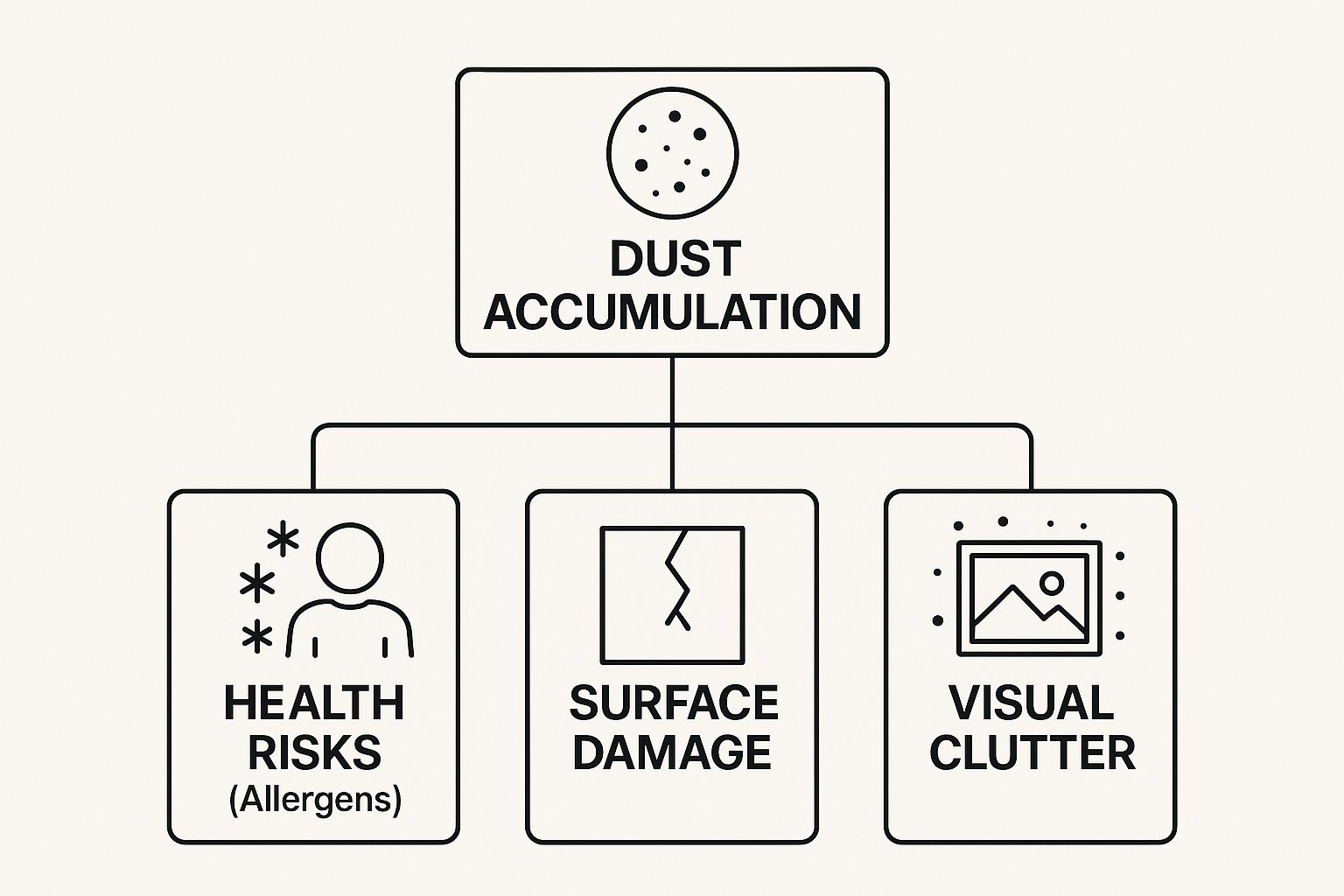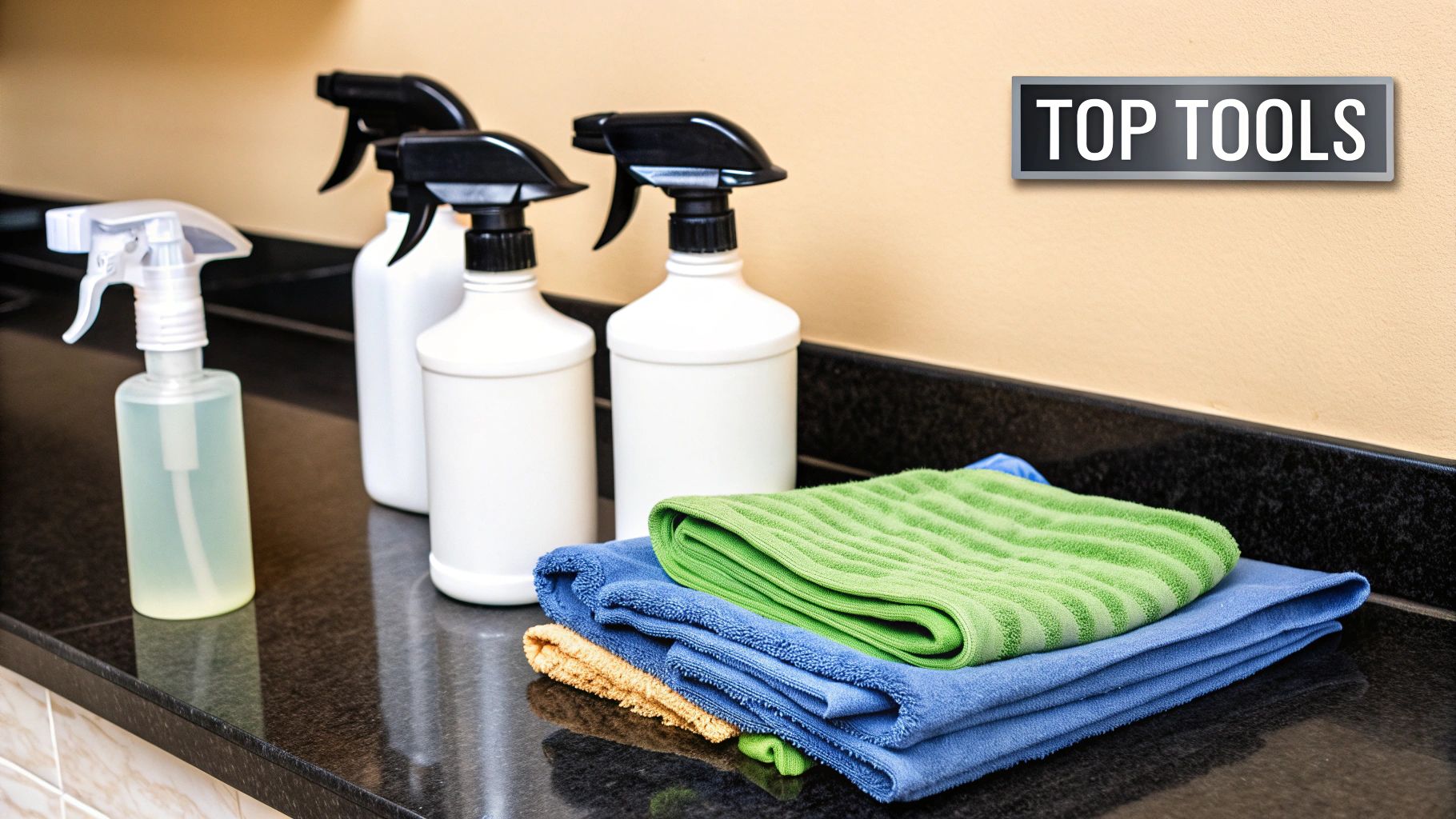For most homes, the simple answer to how often you should dust is once a week. Think of this as your starting point—a solid baseline to keep that pesky layer of dust from building up and messing with your home's air quality. This simple routine is usually enough to handle the day-to-day dust.
Your Simple Guide to Dusting Frequency
While dusting weekly is a great rule of thumb, it’s definitely not one-size-fits-all. Some homes are just natural dust magnets and need a bit more attention.
For instance, if you have furry friends shedding dander, family members with allergies, or live near a busy road, you’ll probably want to dust two to three times per week. The real goal is to find a rhythm that works for your unique home and lifestyle.
This infographic breaks down why dust is more than just an eyesore.

As you can see, letting dust pile up can lead to health issues from allergens, damage surfaces over time, and just make your home feel cluttered.
Building Your Dusting Routine
To get started, think about the different zones in your house. High-traffic areas like the living room and bedrooms—where we shed skin cells and fabric fibers all the time—will always need more attention than a guest room that’s rarely used.
A consistent dusting schedule is less about chasing perfection and more about being proactive with your health. It’s one of the easiest ways to improve your indoor air quality and make your home a more comfortable place to be.
To help you create a schedule that fits your life, here’s a quick reference guide.
Quick Dusting Frequency Guide by Room and Surface
| Area or Item | General Household | Home with Pets or Allergies |
|---|---|---|
| Living Room Surfaces | Weekly | 2-3 times per week |
| Bedroom Furniture | Weekly | 2-3 times per week |
| Electronics (TVs, etc.) | Weekly | Every few days |
| Blinds & Window Sills | Every 2 weeks | Weekly |
| Baseboards & Vents | Monthly | Every 2 weeks |
| Ceiling Fans & Light Fixtures | Monthly | Every 2 weeks |
| Shelves with Knick-Knacks | Every 2 weeks | Weekly |
| Low-Traffic/Guest Rooms | Monthly | Every 2 weeks |
This table gives you a great starting point, but remember to adjust based on what you see in your own home. If a surface looks dusty, it's time to clean it!
For a bigger-picture approach, dusting is a key part of these essential furniture care tips for longevity. And if you're ready to tackle dust head-on, check out our complete guide on how to eliminate dust in your home.
Understanding What Is In Your Household Dust
Ever wondered what that grey fluff accumulating on your shelves actually is? It's way more than just a bit of dirt. Think of it as a microscopic cocktail, a unique mix of particles from both inside and outside your home.
The slightest disturbance—someone walking across the room, flopping onto the sofa, or even a gentle puff of air from a vent—is enough to send these tiny particles airborne.

A huge chunk of household dust is actually made by us. We’re constantly shedding tiny flakes of skin, which become a primary ingredient. Add in some pet dander, fibers from clothes and furniture, and microscopic food debris, and you start to see how our daily lives create a dusty environment.
The Unseen Components of Dust
But the mixture doesn't stop there. Dust is like a sponge, soaking up all sorts of other elements that find their way into our living spaces.
Here’s a quick breakdown of what you're likely dealing with:
- Biological Matter: This is the stuff of life—dead skin cells, pet dander, dust mites and their waste, and even tiny insect fragments.
- Outdoor Intruders: Pollen, soil particles, and soot can easily drift in through open windows and doors, eventually settling on your surfaces.
- Household Fibers: Your carpets, upholstery, clothes, and bedding are constantly shedding microscopic fibers that add to the buildup.
This complex combination means a simple layer of dust is really an active reservoir for common allergens and irritants. It becomes a major player in your home's overall air quality, which is exactly why figuring out how often to dust is so crucial for your well-being.
Beyond what you can see, household dust is a huge contributor to indoor air pollution. Understanding how HVAC technology helps reduce indoor air pollution can give you a better handle on your home's air quality and the role your systems play.
Once you recognize what’s really in that fluff, it’s clear that dusting is less about simple tidiness and more about actively managing your family’s respiratory health. Every swipe of a cloth physically removes these potent triggers from your environment.
How Consistent Dusting Improves Your Health
That layer of dust on your bookshelf isn’t just sitting there quietly. Think of it as a waiting room for irritants, ready to be launched back into the air you breathe. Every time you walk past a table, flop onto the sofa, or even let in a breeze, you're kicking those microscopic particles right back into circulation.
This constant cycle of dust recirculation can make your home a tough place to be, especially if you or your family members have sensitive lungs. It's like stirring up sediment in a clear pond—suddenly, the water is cloudy and full of junk. Regular dusting acts like a filtration system, physically removing these particles before they get a chance to be disturbed.

Sticking to a consistent weekly schedule dramatically cuts down on the airborne triggers that can make allergies and asthma so much worse. Suddenly, this simple chore feels less like a tedious task and more like a powerful step toward a healthier, more comfortable home for everyone.
The Link Between Dust and Respiratory Issues
The connection between household dust and breathing problems is no secret. If you let dust build up for just two weeks, the amount on flat surfaces can jump by over 50%. This directly leads to more particulate matter floating around in the air.
In fact, some studies estimate that up to 30% of asthma flare-ups and rhinitis cases are directly tied to dust exposure. That’s a huge number, and it really underscores why regular cleaning is so important for our health.
By dusting, you’re not just cleaning. You’re physically removing the primary food source for dust mites and getting rid of their waste products—which happen to be potent allergens. You're directly disrupting the allergy cycle right inside your home.
It becomes pretty clear that managing dust is a key part of reducing common allergy symptoms. If you want to dive deeper into creating an allergy-friendly home, our guide on cleaning for allergies has even more practical tips.
Making this simple habit a priority helps ensure the air your family breathes is cleaner and healthier, minimizing the triggers that lead to sneezing, coughing, and other nasty symptoms.
Creating a Personalized Dusting Schedule

Alright, now that we've covered the what and why behind all that dust, let's build a routine that actually fits your life. A generic, one-size-fits-all plan is a fast track to burnout. The real secret is creating a flexible, room-by-room game plan that targets your home's unique dust patterns.
Think of your house as having different "dust zones." Not every surface is created equal, and knowing where to focus your efforts makes the whole process feel less like a chore. High-traffic areas are your top priority, while the quiet, low-use spaces can wait.
This strategic mindset turns dusting from one massive, overwhelming task into a series of small, manageable wins. You’ll spend your time where it counts most, and the result is a cleaner home with way less effort.
Prioritizing High-Traffic and High-Shedding Zones
Your living room and bedrooms are pretty much the headquarters for dust. It’s where you spend most of your time, shedding skin cells and releasing tiny fibers from clothes, blankets, and furniture. These rooms need attention more often—a good, thorough dusting once a week is a solid rule of thumb.
On the flip side, a guest room that’s rarely used or a formal dining area might only need a touch-up every two weeks or even once a month. The goal is to match your cleaning frequency to how much life happens in each room.
Here’s where to focus in your high-priority zones:
- Bedrooms: You spend about a third of your life here, making it a prime spot for skin flakes and dust mites. Hit the nightstands, headboards, and dressers regularly.
- Living Rooms: Upholstered furniture, rugs, and all those electronics are serious dust magnets. Keeping this area clean is key for air quality where your family hangs out.
- Home Offices: Desks and electronics generate a little heat and static, which basically pulls dust particles right out of the air.
Tackling Common Dust Magnets
Some things in your home just seem to attract dust like moths to a flame. Giving these items a little extra attention can make a huge difference in your home's overall freshness and air quality. Weaving these smaller tasks into your routine prevents that heavy, caked-on buildup that’s a pain to clean later.
A smart dusting schedule isn't about cleaning everything all the time. It's about cleaning the right things at the right time. This efficiency keeps you from feeling overwhelmed while keeping your home consistently fresh.
For example, electronics like TVs and computers have a static charge that pulls in dust. A quick wipe with a microfiber cloth every few days keeps them looking sharp. Similarly, window blinds and ceiling fans are notorious for collecting thick layers of grime and should be part of your weekly or bi-weekly plan.
Putting it all together in a comprehensive house cleaning schedule can help you stay organized. By breaking your home into manageable zones and prioritizing the dust hotspots, you create a personalized plan that works for you, not against you.
Why We Dust More Often Today
Ever wondered why the answer to "how often should I dust" seems to have changed over the years? A century ago, cleaning guides were a lot more relaxed about it. So, what gives? The shift from a simple chore to a modern health necessity is directly tied to how our homes have transformed.
Think about it: our living spaces are now packed with synthetic fabrics, plastics, and all sorts of electronics. These modern materials break down into much finer particles than the stuff our great-grandparents dealt with. This new kind of dust isn't just more plentiful—it's also a perfect vehicle for carrying pollutants and allergens all around your home. That's what put a whole new focus on air quality.
From Tidiness to Health
The science of indoor air quality really brought this change to light. If you peek at housekeeping guides from the early 20th century, they often suggested dusting just once every two weeks. Fast-forward to the 1970s, and you'll see health authorities pushing for weekly dusting to fight back against dust mites and particulates linked to asthma and allergies. You can dig deeper into these historical changes in indoor air quality science if you're curious.
Today’s dusting advice is a direct response to our contemporary lifestyles. We now understand that regular dusting isn’t just about looking clean—it’s a science-backed method for maintaining healthier air inside our homes.
This deeper understanding of respiratory health is precisely why experts now agree on a more frequent, proactive approach. It's all about managing the dust in our modern, tightly sealed homes before it becomes a bigger problem.
Answering Your Top Dusting Questions
Even with the best dusting schedule, some questions always seem to come up. From choosing the right tools to tackling those impossible-to-reach spots, let's clear the air on a few common dilemmas.
Think of this as your quick-reference guide to dusting smarter, not harder.
What Are the Best and Worst Dusting Tools?
The right tool can completely change your dusting game. The entire goal is to trap and remove dust, not just fling it into the air where it will happily resettle two feet away.
For that reason, your best bet is always something that actually captures the particles:
- Microfiber Cloths: These are the undisputed champions. Their tiny fibers create a static charge that grabs onto dust like a magnet. Use them dry for light jobs or slightly damp for stubborn buildup.
- Electrostatic Dusters: Working on the same static electricity principle, these are fantastic for getting into tight corners and around delicate items without much effort.
So, what should you avoid? The classic feather duster, ironically, is one of the worst offenders. It mostly just shoves dust around, kicking allergens right back into the air instead of removing them.
An effective dusting tool is one that traps particles, not one that just moves them. If you can see dust floating in the air after you clean, it's a sign your tool isn't doing its job properly.
Do Air Purifiers Help with Dust?
Absolutely, but think of them as a partner in crime to your dusting routine, not a replacement for it. An air purifier equipped with a HEPA filter is a pro at capturing tiny airborne particles—dust, pollen, pet dander—while they're still floating around.
This means it drastically cuts down on the amount of dust that can settle on your furniture in the first place. But it can't do anything about the dust that’s already landed. You'll still need to physically wipe down tables and shelves.
It's a team effort: the air purifier plays defense by catching dust mid-air, while your microfiber cloth plays offense, clearing away everything that's already settled.
What Is the Best Way to Dust Blinds and Fans?
Ah, the two most notorious dust magnets in any home.
For window blinds, the simplest trick is to close them flat and wipe them down horizontally with a damp microfiber cloth. Then, just flip the slats the other way and repeat on the other side. Done.
For ceiling fans, grab an old pillowcase. Slide it over one blade at a time and pull it back slowly, trapping all the dust, grime, and cobwebs inside. This genius hack prevents a dust shower all over your furniture and floors. Staying on top of these spots keeps that heavy, caked-on gunk from ever building up.
Ready to hand over the dusting duties to the experts? The team at Custom Maids has been making homes in Mid-Michigan spotless since 1982. We offer customized cleaning plans to fit your life, from weekly touch-ups to deep cleans. Learn more about our professional cleaning services and get your free consultation today!

